Oslo, the way to the Jotunheimen National Park and hiking from Gjendesheim to Bessheim
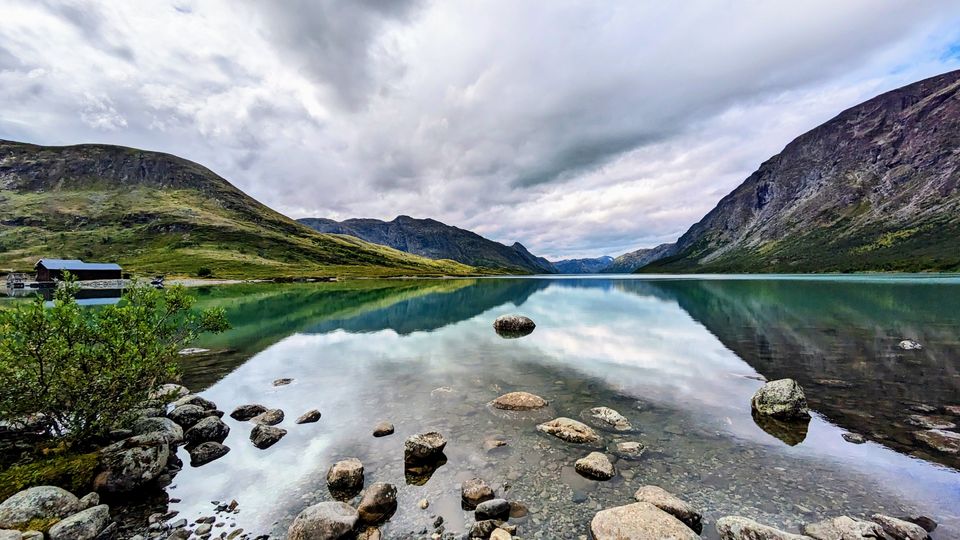
When Alessandra and I unfurled our wings of steel, lifting off from Vienna's storied ground, it was as if the plane carried not just passengers but a cargo hold of dreams. We soared over continental stretches, a tapestry of earth and water far below us, until we touched down in Oslo—a city that serves as Norway's beating heart, its rhythms a fusion of old-world allure and new-age charm.
Night had already enshrouded the city, a blanket of darkness embroidered with city lights. Lugging our backpacks, emblems of adventure, we meandered through the labyrinth of streets to find our hotel. Nestled near the National Theater, an institution where drama and history are inseparable, the location seemed to promise its own sort of drama for our trip. As our heads met pillows, sleep arrived as quickly as a winter night, eclipsing our consciousness.
A day in Oslo, Norway
Sunday heralded itself with a soft dawn, melting the darkness away as we awoke. Our day commenced not with the rush of a starting gun but with the leisurely pace of a sightseeing saunter, as if the city itself whispered, "Linger a while, and know me better." Oslo's architectural marvels and sculpted parks unfurled like pages in an untold storybook.

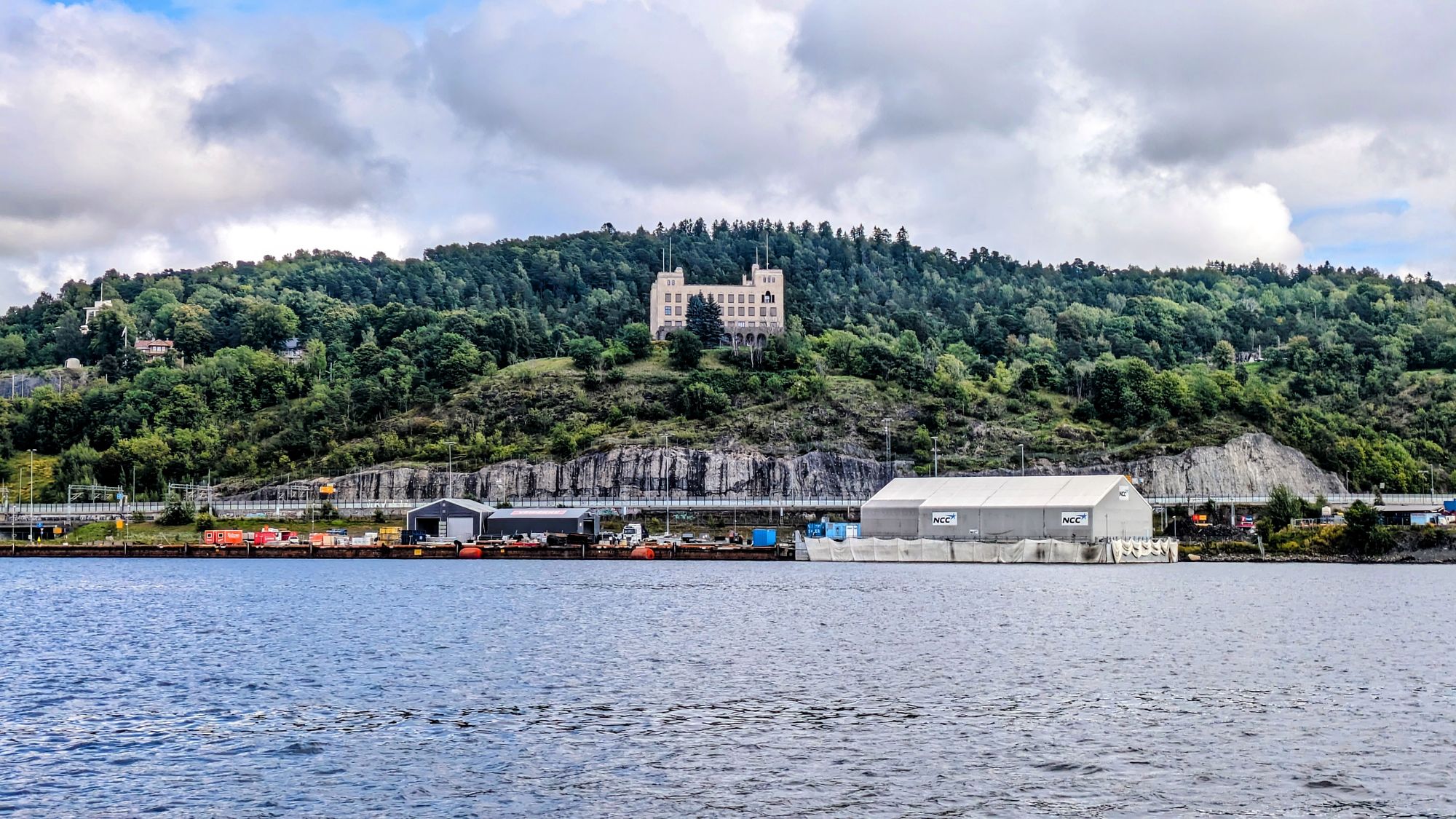
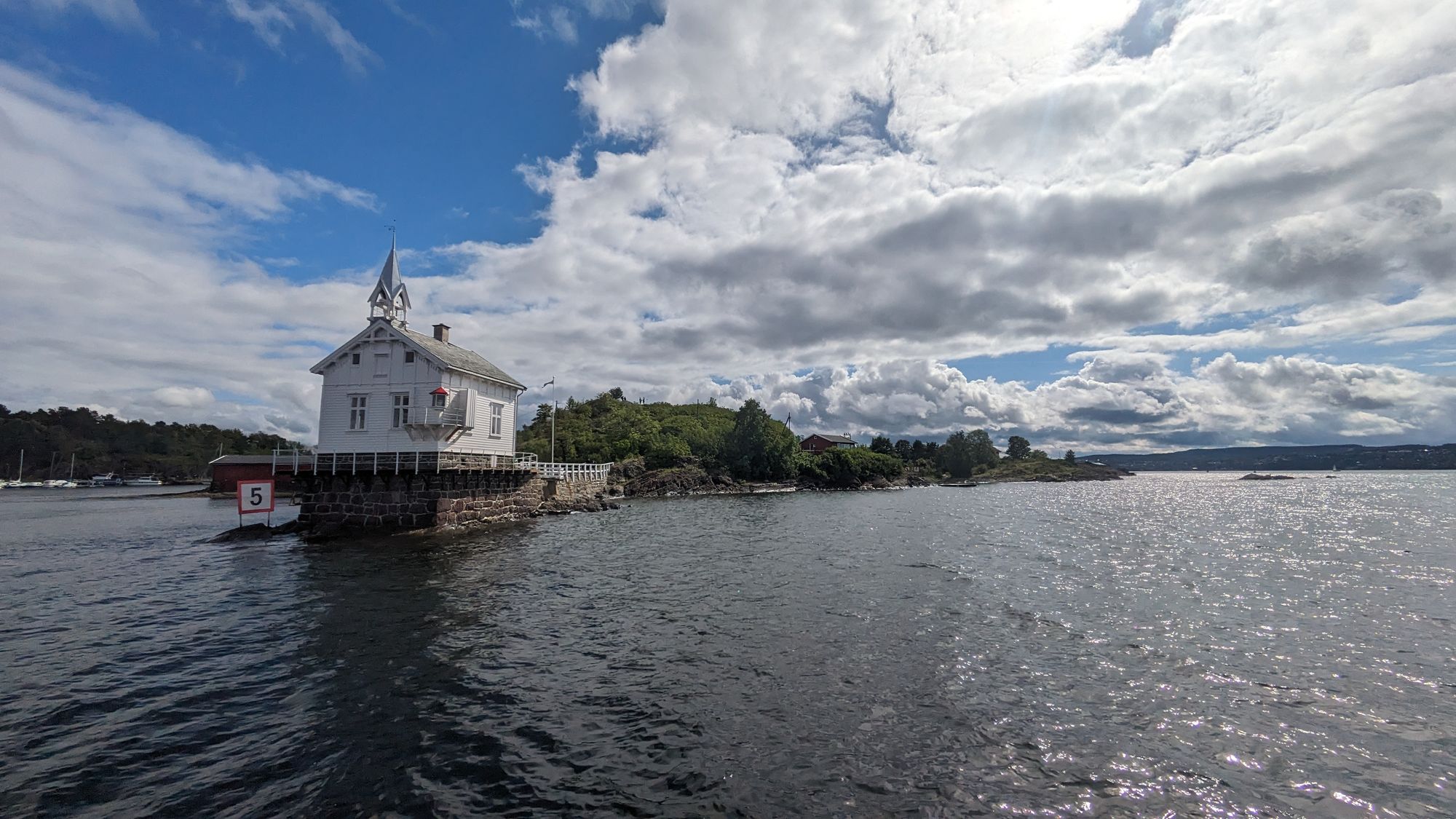
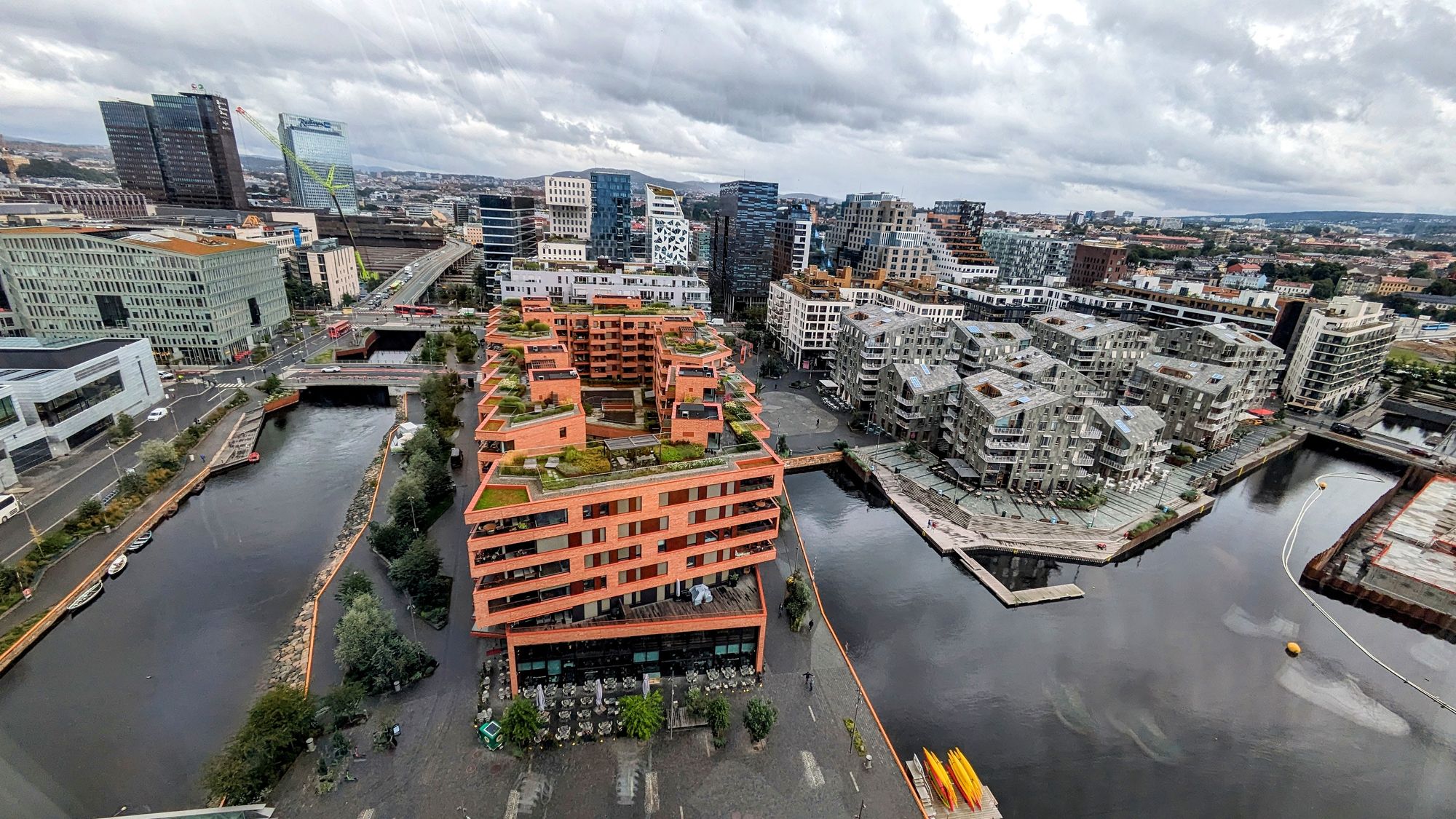
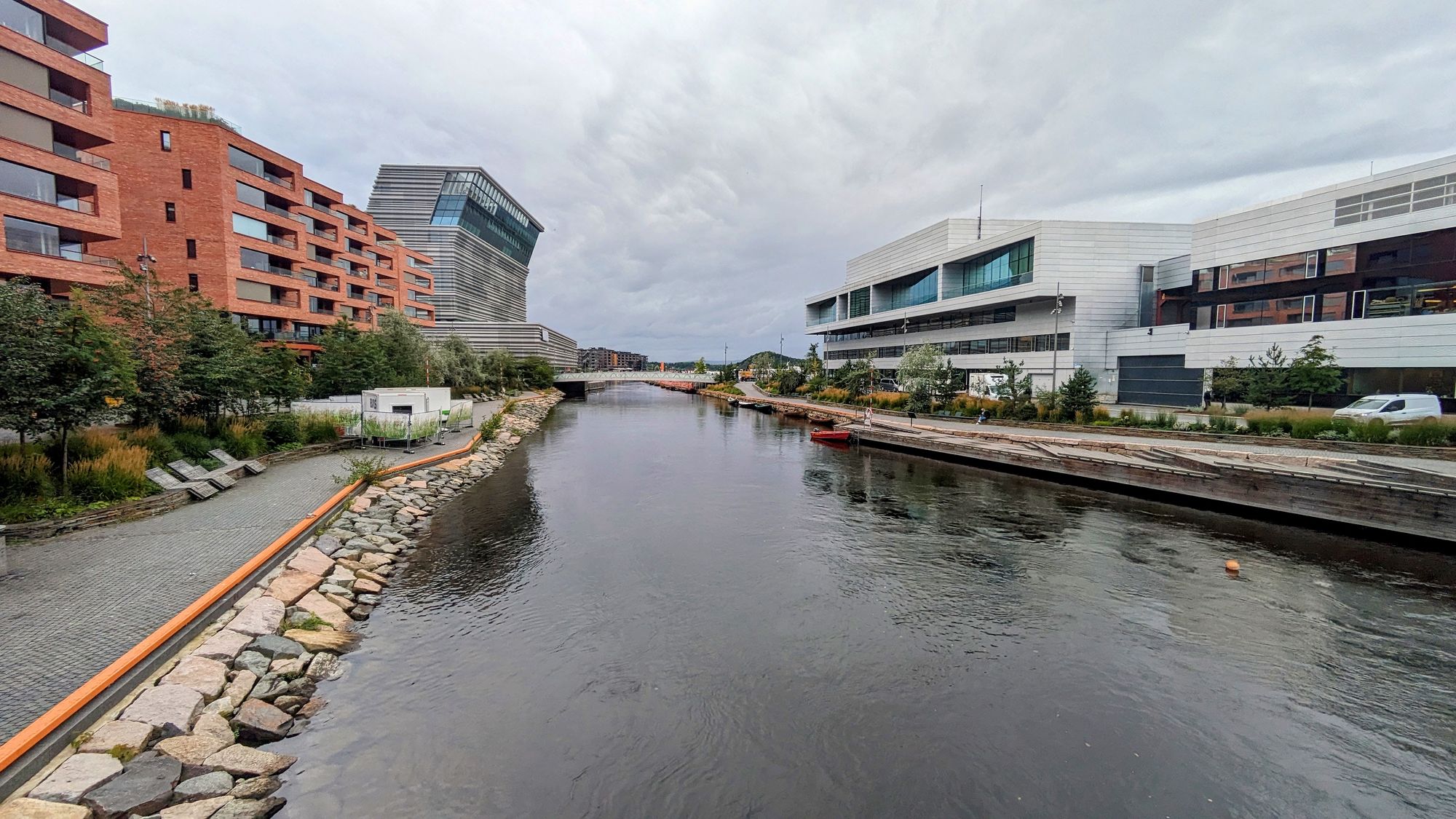

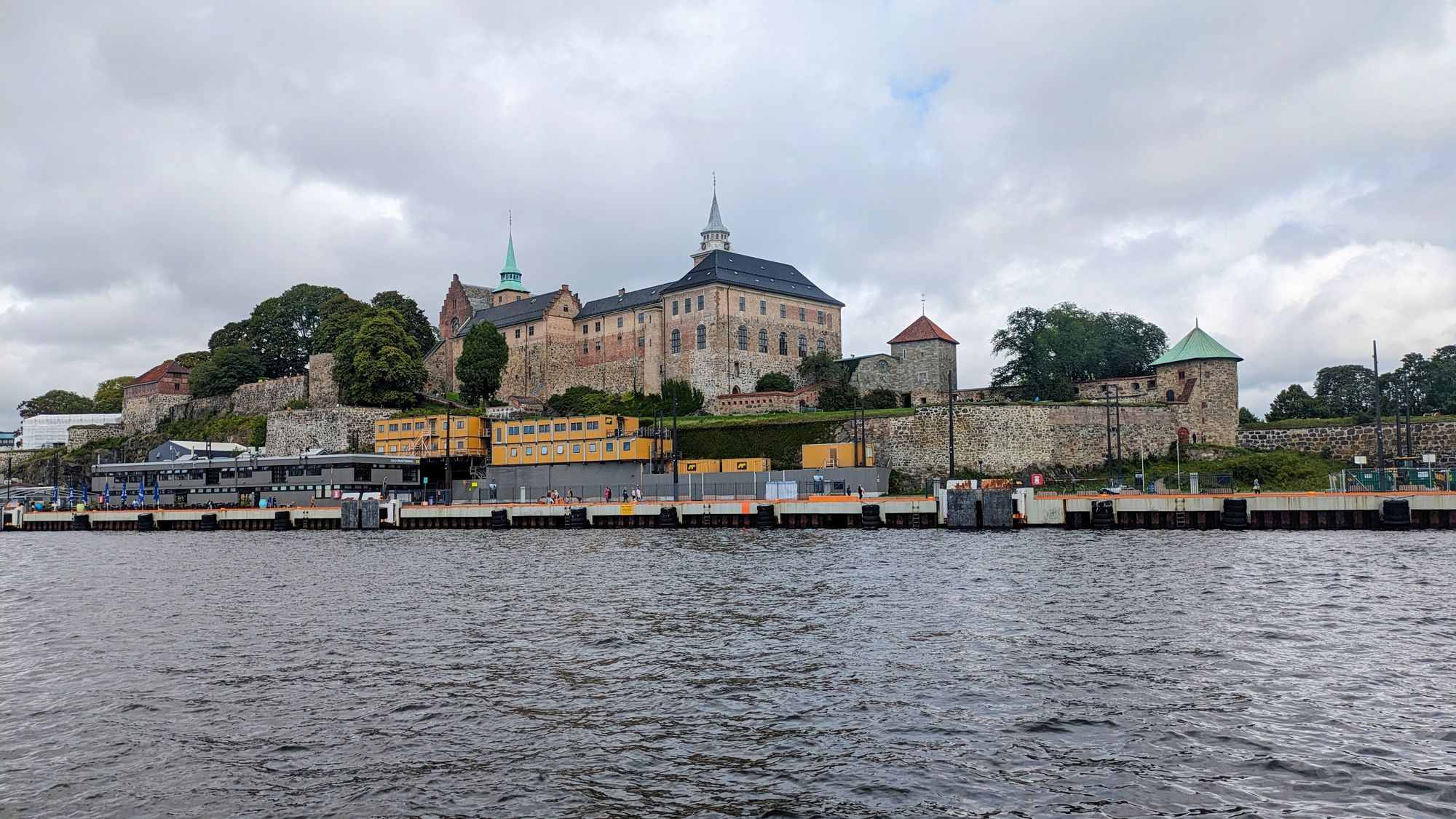
Our hunger for exploration was momentarily satiated with another form: breakfast. We found ourselves at Museum Island, a sanctuary of culture surrounded by tranquil waters. In a quaint bakery that felt plucked from a postcard, the aroma of freshly brewed coffee flirted with our senses while croissants, flaky and butter-rich, seemed to whisper secrets only the tongue could decipher. With every sip and bite, we tasted not just the fare but the essence of the place—a blend of culinary craftsmanship and local atmosphere, as enriching as it was delicious.
With the morning sun still stretching its golden fingers across the sky, Alessandra and I boarded a vessel destined for the labyrinthine waterways of Oslo's fjords. Here, the city's pulse gave way to a different rhythm—each wave a heartbeat, each island a thought suspended in the immense mind of nature. Majestic houses clung to the shorelines like ornate bookmarks holding the place of untold stories. Weather was our silent companion on the boat—sunlight gently dappling the water, air crisp but welcoming. For those moments, the fjord was not just a geographic feature, but a kaleidoscope of sensations and visuals, stitched into our memories with the iridescent thread of experience.
Disembarking from our nautical foray, we aimed our footsteps toward the Opera House. This architectural marvel, both angular and fluid, seemed to rise from the water as if preparing to take flight. With its façade akin to an iceberg, it was a poignant reminder of Norway’s deep connection to both the sea and snow. Not far away, we discovered the Deichman Public Library, a repository of human thought, its modern design embodying the progressiveness that marks Oslo’s civic life. In its quietude, there was an unspoken invitation to learn, to grow, to be.
Yet, even as we immersed ourselves in culture and art, a mundane necessity beckoned: the acquisition of a gas canister for our stove. Ah, the juxtaposition of adventure and practicality! But the city observed a Sunday quietude; most shops were as closed as a sealed book. Our first quest led us to a gas station—a lonesome island in an urban sea—only to find that it, too, had no store to speak of. Our need unmet, a sense of urgency flickered like a candle's flame; the next gas station lay far beyond our immediate reach. Time was both an ally and a foe, pacing us, urging us, reminding us that even adventurers must bow to the clock’s relentless march.
Just as we were about to surrender to the day's caprices, hunger nudging us toward a restaurant in Oslo's bustling center, Fate intervened in the guise of a stranger. Dressed in an Arc'teryx jacket, La Sportiva shoes, and climbing trousers, he seemed to wear his love for the great outdoors like a second skin. It was as if the universe had orchestrated this meeting, and so I approached him.
Upon inquiring about a place to purchase a gas canister on this Sunday Sabbath, his laughter echoed both the joy and irony of our situation. "Everything's closed," he said, yet something in his demeanor suggested that this chapter of our story was not at its end. "Wait here," he instructed, inviting us into the courtyard of his nearby residence. As we waited, the minutes felt heavy with the weight of hopeful anticipation.
Our faith was rewarded. In less than the span of a brief daydream, he returned, not just with a gas canister but also with his own stove. The moment was a small miracle, crystallized in the flame that danced atop the stove when he tested it. "It's full, and it's yours," he declared. In a world driven by transactions, this was an act of pure generosity, as he declined my offers of monetary compensation.
We discussed our upcoming journey to Jotunheimen National Park, our intentions woven into a seven-day tapestry of exploration. His words of caution came painted in shades of awe and warning; he spoke of a landscape made erratic by rainfalls the likes of which come once in half-centuries, of floodings that had forced roads to close. "The weather has been mad," he said, a foreshadowing that would later prove prescient.
We bid him farewell, hearts lighter, hopes higher, but more than anything, bolstered by this encounter with human kindness. He was not merely a passerby in our adventure but an emblem of the serendipity and grace that shape all great journeys. Thus, with our canister full and our spirits lifted, we turned our footsteps toward the next immediate horizon—a quest for sustenance. Like adventurers keen on deciphering a new layer of a sprawling map, we pressed on to find a restaurant, the day still imbued with the heady aroma of possibility and the delicious anticipation of a meal well-earned.
Ah, the subtle symphony of a good Chinese meal, each dish a different note, blending into an opus of flavors that spoke both to our hunger and our senses. The dim sum, stir-fries, and delectable sauces seemed to converse with our palates in a language older than words. Satiated and profoundly content, we retreated to our hotel room. There, sleep enveloped us like an old, cherished quilt, stitching the events of the day into the fabric of our dreams.
From Oslo to Gjendesheim in Jotunheimen national park
By the time the first rays of light brushed against the Oslo sky, we were already stirring. Our internal clocks, it seemed, were attuned to the call of adventure. From the hotel to Oslo's bus terminal, we walked through streets muted by the early Sunday morning, the city still caught in the last, sweet notes of its nightly lullaby. Provisions for our journey—a collection of snacks, water, and other essentials—were quickly secured. Practicality, too, has its poetry.
Boarding the bus to Fagernes, we settled into our seats as the vehicle hummed to life, setting the stage for the shifting tableaus that would fill the windows along our journey. The Norwegian landscape unfurled like a living tapestry—each thread a road or river, each patch of color a meadow or mountain. But the beauty was tinged with the somber hues of reality. Flooded campsites, half-submerged huts, and houses drowning save for their rooftops stood as stark reminders of the stranger's warning. Nature, in its majesty, also bore an element of menace.
Yet even amid such alarming scenes, the perennial beauty of Norway asserted itself. Fjords appeared like sapphire incisions in the earth, crowned with cliffs and lined with trees. Forests stood dense and impenetrable, a verdant kingdom whispering secrets to those who would listen. The juxtaposition was poignant—a landscape both inviting and forbidding, encapsulating the dual nature of any journey. The ride offered us a diverse tableau of Norwegian life and nature, each element a distinct brushstroke in the ever-expanding painting of our experience.
As the wheels of our second bus gripped the rain-soaked roads, we departed Fagernes for Gjendesheim. The sky, it seemed, had opened its floodgates just as we were leaving, as if bidding us a misty adieu. Our journey led us over a plateau, a windswept expanse where the very air seemed to breathe a rugged freedom. It was here, amid the elements, that I saw them—the first reindeers of my life. Their graceful forms skimmed the landscape like wraiths, an experience as fleeting as it was memorable.
We arrived at Gjendesheim which is at the edge of the Jotunheimen national park, where the rain graciously took its leave, revealing before us the serene beauty of Lake Gjende. This emerald gem of a lake would be our nearest neighbor. Gjendesheim offered a hut with simple amenities: places to sleep, a modest menu of food, and storage options for extra luggage, which we took advantage of. A humble buffet stood sentinel near the ferry dock, a gateway to other destinations along the lake like Memurubu and Gjendebu.
About 200 meters from this hub of human activity, we found our slice of paradise. Our tent rose on the shore of the lake, its canvas walls framing a view that poets would struggle to describe. Post-setup, I treated myself to the simple indulgence of a hot dog from the buffet—a culinary nod to the commonplace amid the extraordinary.
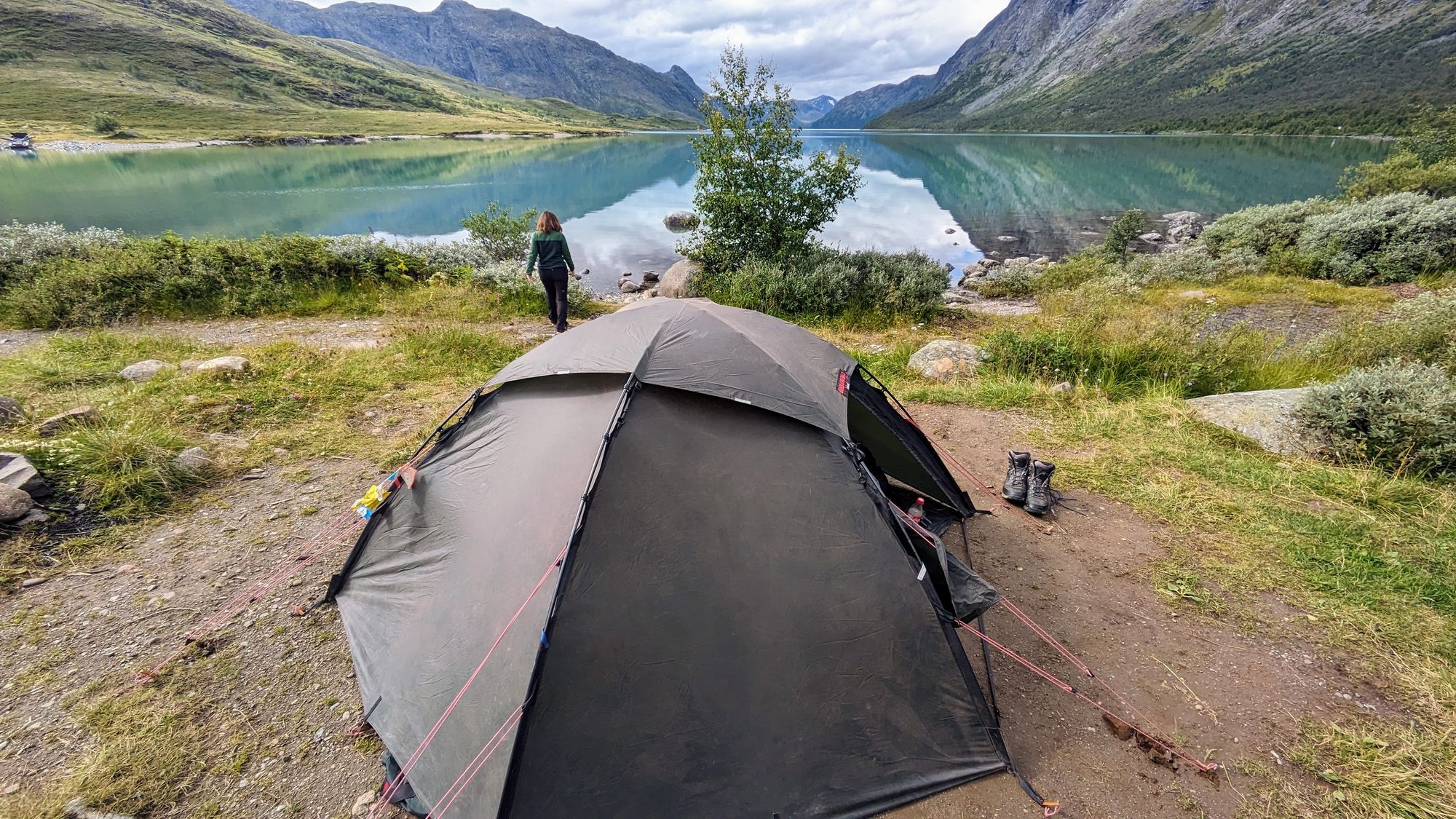
But the skies had another act in their meteorological play; rain returned, relentless and heavy. We retreated to the communal warmth of the Gjendesheim hut for lunch. There, we struck up a conversation with an American couple who, like us, had set their sights on conquering the Besseggen Ridge, Norway's most renowned natural walkway. A quick consultation with the weather gods via our phone revealed an unwelcome prophecy: the rain was to be our constant companion for the entire next day.
Tackling Besseggen in such conditions would be neither wise nor safe, so we opted to give the sky its day of tears. The couple, bound by tighter constraints of time, had no such luxury. We exchanged goodbyes, a fleeting connection with kindred spirits, before returning to our tent, the canvas dwelling that was, for now, our home amid the wilderness.
Rainy day, Bessegen has to wait
When dawn stretched its fingers through the gray curtain of sky, we awoke to the rhythm of rain pattering on our tent—an ambient symphony of droplets and canvas. The sound, while comforting in its lullaby-like cadence, heralded the undeniable fact that our intended journey over the Besseggen Ridge to Memurubu would not unfold this day.
We ventured to the small buffet near the dock, where cinnamon rolls—sweet spirals of comfort—and coffee awaited us. As the hot liquid warmed our hands and the sugary pastry sweetened our spirits, we contemplated alternative plans. A fellow traveler, perhaps sensing our restless itch for exploration, suggested a loop hike to Besseheim and back. The idea felt right; a 12-kilometer jaunt that promised arresting landscapes and, crucially, would not suffer unduly from the rain.
And so it was decided. If the sky insisted on its weeping, then let it. We would adapt, for such is the essence of adventure: to bend like a willow in the wind, resilient and undeterred, finding a way to dance even in the downpour.
With essentials stowed away in a compact backpack—rain gear for the skies' caprice, snacks for sustenance, and water as our liquid ally—we embarked on our newly-charted course. The signs beckoning toward Besseheim were our north stars; their clear directions left little room for misstep.
Our path led us up a ridge just beyond Gjendesheim, where a pause and a glance back rewarded us with views as lavish as an epic poem. Lake Gjende lay sprawled like a tranquil titan, its emerald surface set like a gem amid the rough-hewn cradle of mountains. There, where the water met the peaks, nature’s own canvas was painted in tones of stone and liquid jade.
But as if summoned by the drama of the landscape, rainclouds regrouped over the plateau we'd just ascended. The moisture was met not with sighs but smiles. Out came our rain gear, a plastic armor against the heavens' tears. In such a setting, even rain became a player in the spectacle, adding a dynamic sheen to the scenery, a new texture to our day.
Descending the ridge toward Besseheim, our footsteps were guided by the allure of warmth and respite. There, within the welcoming walls of a local hotel and restaurant, we warmed the cold periphery of our bodies with cups of steaming coffee. Each sip was not just a gulp of heat, but a small, comforting celebration—a toast to the serendipitous and ever-unfolding journey that awaited us.
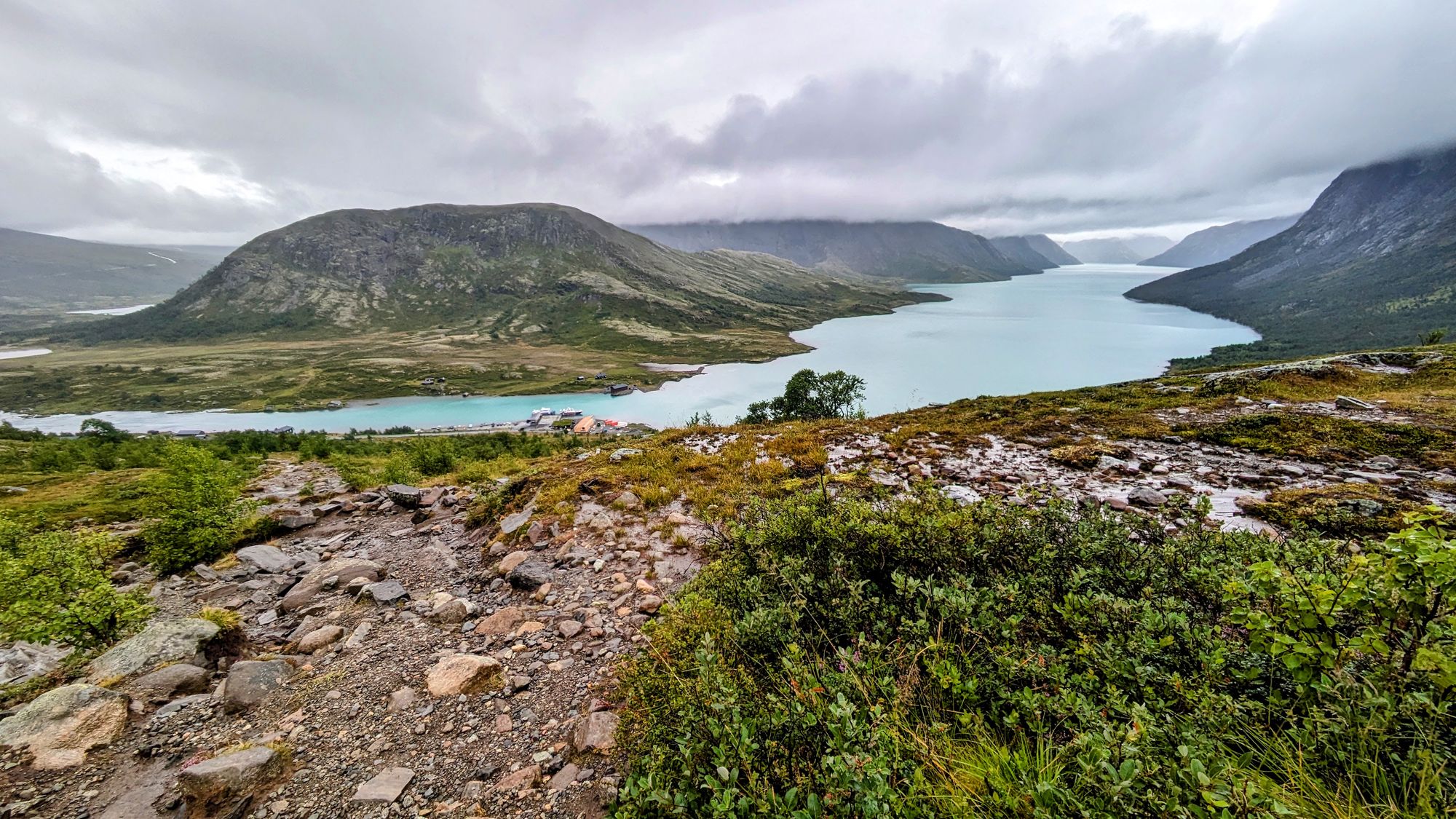
Emerging from our brief respite, we were greeted by rain—again. Its familiar drumming seemed to say, "I'm still here, and so are you." With a nod to the heavens, we took to the trail that unfurled behind the Besseheim hut, heading toward the enigmatic waters of Bessvatnet.
The journey led us first to the Bessa, a river nurtured by the lake we aimed for. Small waterfalls graced our path, each a liquid sculpture animated by nature's artistry. Now the rain was insistent, thudding against our jackets like a thousand tiny drumbeats, serenading our expedition.
After a time, we reached Bessvatnet—a sprawling expanse of water that reflected the gray of the clouds. With the rain unabated, we made a choice; turning left, we set a course for our home base, Gjendesheim. The trail was well-marked, each signpost a sentinel guiding us through an ever-changing tapestry of alpine terrain. Here, the landscape put on another costume: rocks gave way to vibrant grasslands, punctuated by the occasional sheep, whose woolly forms seemed as native to the land as the rocks themselves.
Finally, we found ourselves atop the ridge overlooking Gjendesheim, the loop coming full circle. A set of stone steps invited us downward, threading through patches of grassland like stitches in a quilt. At last, our tent came into view, a small citadel by the shores of Lake Gjende. We descended, each step a small journey in itself, each moment a bead on the string of experiences that was our time in this sublime wilderness.
We stowed our small daybag within the sanctuary of our tent, like depositing a chapter into the ongoing narrative that was our grand adventure. Then we wandered back to the hut, where sustenance and society awaited. Over plates filled with hearty fare, conversation flowed as easily as the streams outside. This time, we found camaraderie with some Germans, their accents and stories adding another layer of texture to our day.
Eventually, farewells were exchanged, pulling us back toward the fabric shelter that had become our temporary home. As we walked, I thought about how every interaction, every meal, and every step taken were small but meaningful elements of our journey, each one adding weight and color to our experience in this far-off land.
Reaching our tent, we sought the unique solace that only the insides of such a simple structure can offer. Sleep came to us not as a necessity, but as a gift—a brief interlude in a symphony of experiences, a rest between the movements of our Jotunheimen adventure. With that, we closed our eyes, each of us individually and both of us together, eager for the rest, but even more eager for the chapters yet to be written.
The evening's embrace grew stronger as we settled into our tent, cocooned by the gentle sounds of nature, the whispers of rain, and the memories of the day. Every heartbeat, every soft breath taken was a testament to the day lived fully, to connections forged, and to the raw beauty of Jotunheimen that surrounded us.
As sleep beckoned, drawing us into its restful grasp, the promise of tomorrow fluttered gently in our minds. For with the new day, the iconic Besseggen Ridge awaited, ready to offer its own tales, its own challenges, and its own splendor. But that, dear reader, is a story for another day.
